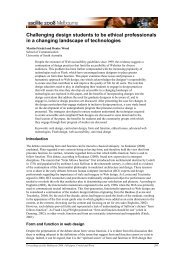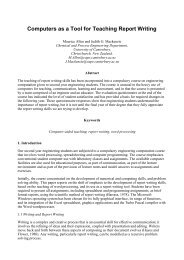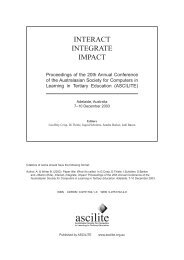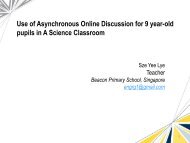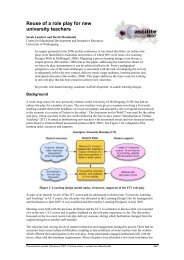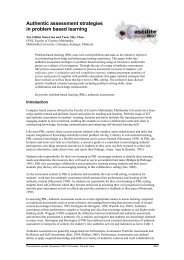Gaming frequency and academic performance - ascilite
Gaming frequency and academic performance - ascilite
Gaming frequency and academic performance - ascilite
Create successful ePaper yourself
Turn your PDF publications into a flip-book with our unique Google optimized e-Paper software.
358 Australasian Journal of Educational Technology, 2008, 24(4)<br />
were measured using Likert scales, <strong>and</strong> additional comments were encouraged<br />
throughout.<br />
Due to potential issues of privacy surrounding the use of examination results for this<br />
research, from the outset advice was sought from the University’s Data Privacy<br />
Officer. Two stipulations were made: 1) in order to comply with the UK Data Protection<br />
Act <strong>and</strong> University regulations, explicit permission needed to be obtained from<br />
participating students to allow the analysis of questionnaire results in conjunction with<br />
their individual examination marks (retrieved from the University’s examinations<br />
database); <strong>and</strong> 2) students’ personal details had to be kept strictly anonymous in any<br />
publication. The objectives of the research, along with the two stipulations, were<br />
clearly stated on the front page of the questionnaire. Students were obliged actively to<br />
place a tick in a box to confirm they agreed with these terms before they could proceed<br />
to the questionnaire.<br />
A pilot survey was carried out with 20 undergraduate students. Once the procedures<br />
<strong>and</strong> questionnaire had been finalised, all undergraduate students at the University<br />
were sent a st<strong>and</strong>ard email containing the details described above <strong>and</strong> asking them to<br />
participate in the survey (details of the duration <strong>and</strong> timing of the survey are specified<br />
in the next section). The emails were sent using an electronic mailing list which<br />
contained the st<strong>and</strong>ard University email accounts for all undergraduate students<br />
(approximately 7,000 at the time of the project), allocated to them at the time of their<br />
enrolment at the University. An Internet link was included in the email directing<br />
students to the online questionnaire. All responses were automatically stored onto an<br />
Access database for subsequent analysis. In order to verify the legitimacy of responses,<br />
students were required to state their unique student identification number on the<br />
questionnaire. This also helped to protect against the possibility of bogus participants<br />
<strong>and</strong> duplicate questionnaires being completed by individual students.<br />
Results<br />
An encouraging 1,187 responses were obtained (a rate of 17%), although several could<br />
not be used for the final analysis due to two main reasons: 1) incomplete answers to<br />
the questionnaire; <strong>and</strong> 2) inadmissible cases, where assessment results were<br />
unavailable (students on an intercalary year, postgraduate research, studies<br />
suspended, <strong>and</strong> so forth). Further, in order to derive valid comparisons of assessment<br />
results, two additional restrictions were placed on the validity of responses.<br />
Respondents had to be (a) registered on full degree schemes at Level 1, Level 2 or<br />
Level 3 (normally respectively representing first, second or third year of study); <strong>and</strong> (b)<br />
studying under the conventional University modular structure (i.e. to be studying for<br />
120 credits in their year of study, thus being full time students). Strictly applying these<br />
criteria brought the final number of valid responses down to a still very usable 713.<br />
Students’ <strong>academic</strong> <strong>performance</strong> was measured by taking their assessment results for<br />
all modules studied during the 2003 to 2004 <strong>academic</strong> year. The survey was<br />
administered in mid-June 2004, after the completion of all assessments, but prior to the<br />
summer vacation <strong>and</strong> for a total of 14 days from when the original invitation email<br />
was sent (see above). Using these assessment results, an overall examination mark for<br />
each student was then calculated as a percentage using the University’s st<strong>and</strong>ard<br />
procedure. The majority of results are derived from traditional formal examinations,<br />
but due to the broad variety of subject areas incorporated into this analysis, students’



